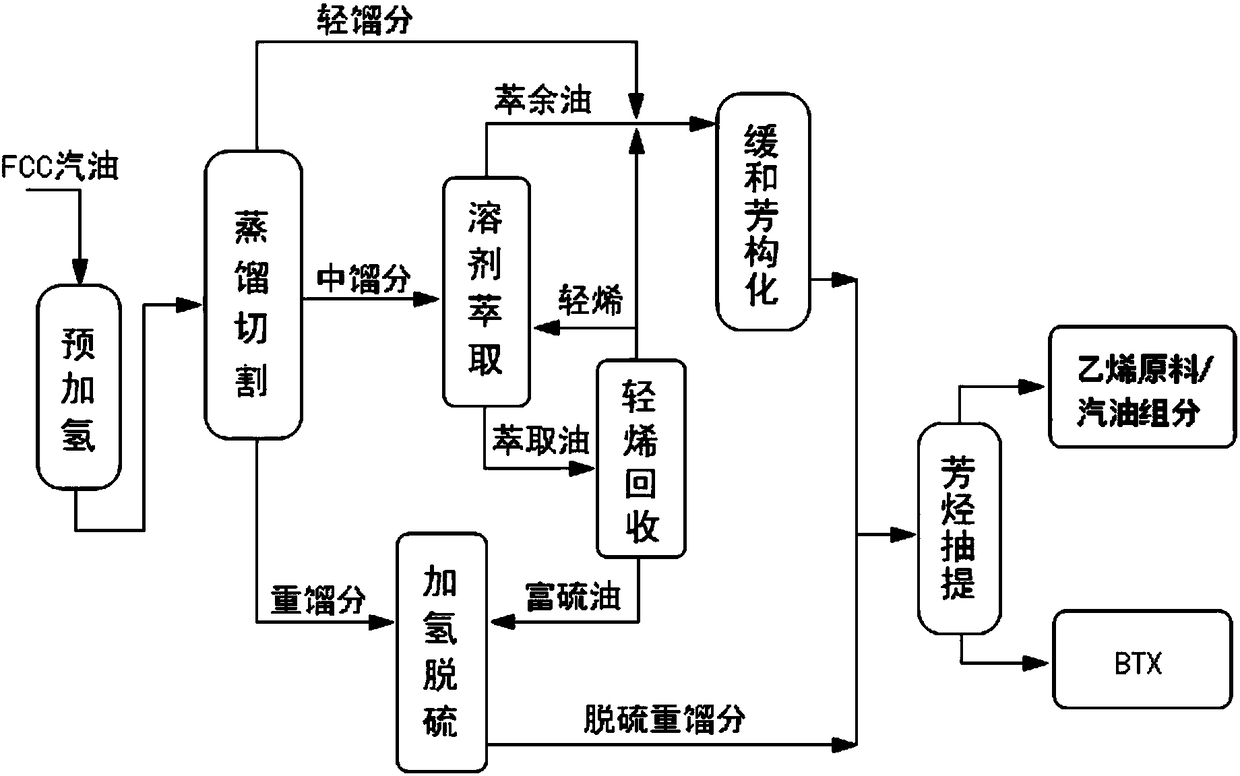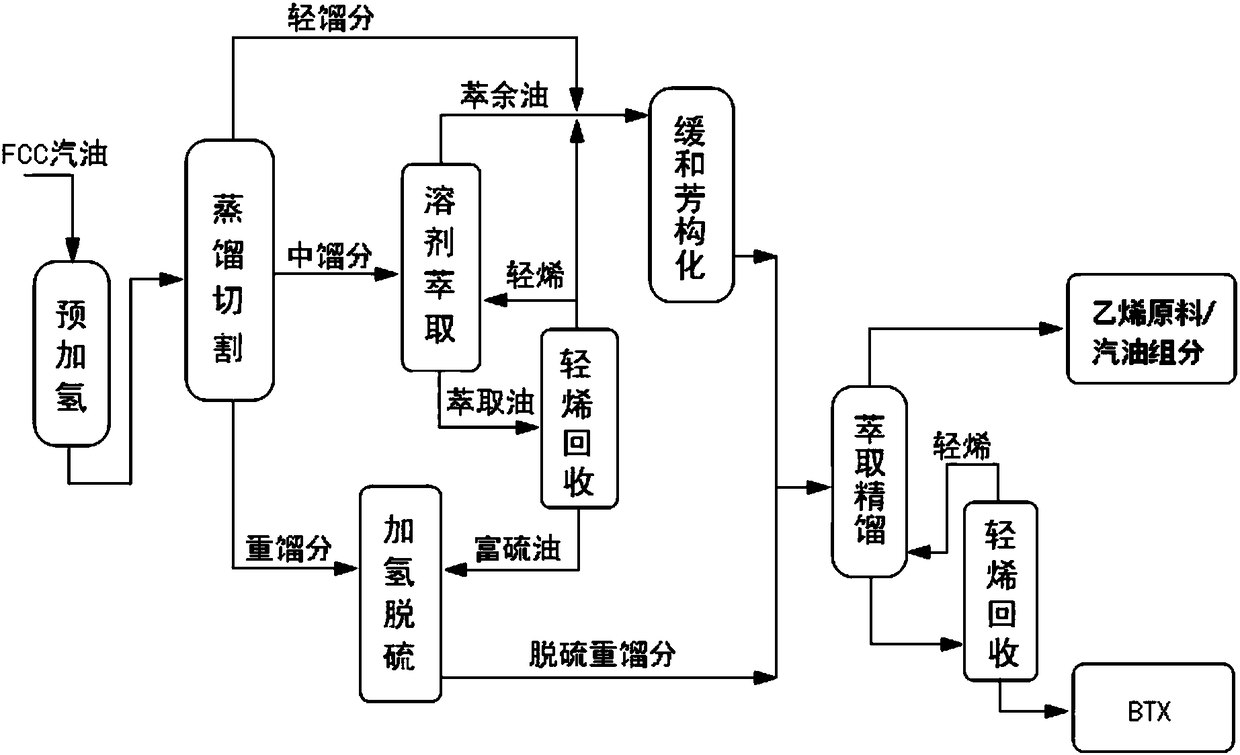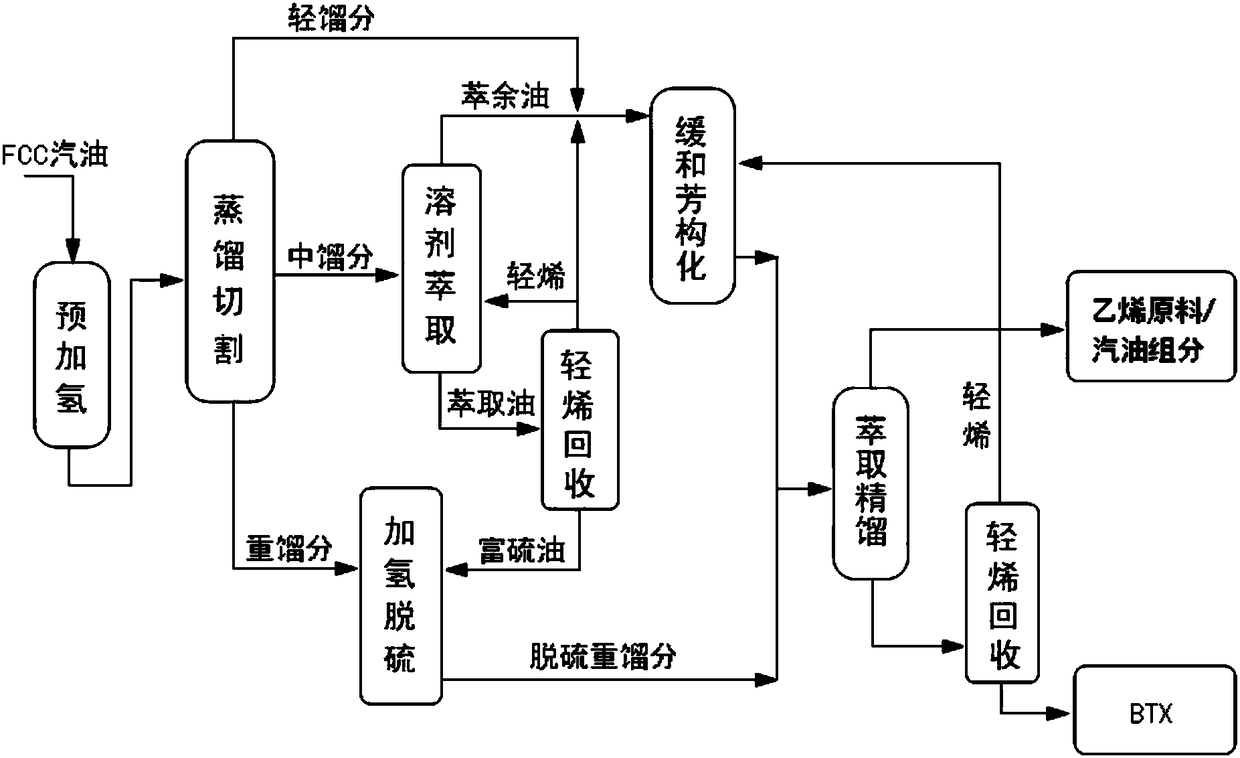Method for maximally producing aromatic hydrocarbons from catalytic cracking gasoline
A technology for catalytic cracking of gasoline and aromatics, applied in chemical instruments and methods, molecular sieve catalysts, hydrocarbon oil treatment products, etc., can solve problems such as inability to convert into chemical products, achieve long-term stable operation, save production energy consumption, benzene The effect of low content
- Summary
- Abstract
- Description
- Claims
- Application Information
AI Technical Summary
Problems solved by technology
Method used
Image
Examples
Embodiment 1
[0067] 1. Preparation of aromatization catalyst
[0068] 1) Preparation of catalyst precursor
[0069] At room temperature, the nanoscale HZSM-5 molecular sieve with a silicon-aluminum ratio of 25 and pseudo-boehmite were physically mixed in a ratio of 4:1 to obtain a catalyst precursor.
[0070] 2) Ion exchange modification
[0071] The catalyst precursor was ion-exchanged by using a constant temperature water bath method, specifically dissolving sodium hydroxide in deionized water, mixing it with the catalyst precursor, and stirring it in a water bath at 90°C for 2 hours, so that the loading capacity of sodium was about 0.2 % by weight, followed by drying at about 120°C for about 8 hours and firing at about 540°C for about 4 hours.
[0072] 3) The first modification treatment
[0073] Using the equal-volume impregnation method, the first modification treatment is carried out on the catalyst precursor treated by ion exchange, specifically dissolving ammonium dihydrogen pho...
Embodiment 2
[0090] 1. Preparation of aromatization catalyst
[0091] 1) Preparation of catalyst precursor
[0092] At room temperature, the nanoscale HZSM-5 molecular sieve with a silicon-to-aluminum ratio of 25 and pseudo-boehmite were physically mixed at a ratio of 9:1 to obtain a catalyst precursor.
[0093] 2) Ion exchange modification
[0094] The catalyst precursor was ion-exchanged by using a constant temperature water bath method, specifically dissolving sodium hydroxide in deionized water, mixing it with the catalyst precursor, and stirring it in a water bath at 90°C for 2 hours, so that the loading capacity of sodium was about 0.5 % by weight, followed by drying at about 120°C for about 8 hours and firing at about 540°C for about 4 hours.
[0095] 3) The first modification treatment
[0096] Using an equal-volume impregnation method, carry out the first modification treatment on the ion-exchange-treated catalyst precursor, specifically dissolving lanthanum nitrate in deionize...
Embodiment 3
[0112] like figure 1 As shown, the method of utilizing catalytic cracking gasoline to maximize the production of aromatics in this embodiment includes the following steps:
[0113] 1. Prehydrogenation
[0114] The composition of the catalytic cracking gasoline raw material in this embodiment is shown in Table 5.
[0115] Table 5 Composition of catalytic cracking gasoline feedstock
[0116]
[0117] In the presence of a pre-hydrogenation catalyst, the above catalytic cracked gasoline is pre-hydrogenated to obtain a pre-hydrogenation catalytic cracked gasoline; wherein the pre-hydrogenation catalyst is a nickel-molybdenum bimetallic catalyst, which consists of (mass content%): Al 2 o 3 90.5%, Ni6%, Mo 3.5%; the pre-hydrogenation process conditions are: control the reaction temperature at 130°C, the hydrogen-oil ratio is 5, and the volume space velocity is 3h -1 .
[0118] After the above-mentioned pre-hydrogenation, the light sulfur compounds in the catalytic cracking g...
PUM
 Login to View More
Login to View More Abstract
Description
Claims
Application Information
 Login to View More
Login to View More - R&D
- Intellectual Property
- Life Sciences
- Materials
- Tech Scout
- Unparalleled Data Quality
- Higher Quality Content
- 60% Fewer Hallucinations
Browse by: Latest US Patents, China's latest patents, Technical Efficacy Thesaurus, Application Domain, Technology Topic, Popular Technical Reports.
© 2025 PatSnap. All rights reserved.Legal|Privacy policy|Modern Slavery Act Transparency Statement|Sitemap|About US| Contact US: help@patsnap.com



